the term “butter” is now “back-troweling”
Tile installation techniques have changed over time. The changes have occurred because of changing technology in tile manufacturing, tile installation failures (for example: spot bonding), and due to a better understanding of how to accomplish needed mortar coverage.
Much like the actual techniques, terms concerning tile installation techniques have been modified or redefined by the NTCA Technical Committee when needed. The need to clarify or redefine the terms “back-butter” and “buttering” was the decision approved by the NTCA Technical Committee, and a subcommittee of the Technical Committee was formed to complete the task.
As the committee started its work on the terms, differences in definitions of back butter and buttering became evident, mainly as regional differences. Because of these differences, the committee decided to change the old terms and definitions to eliminate confusion. Keeping the old term names but using new definitions would not reduce the regional confusion, as experience has shown it is difficult to change the mindset of installers if definitions are changed, but not the term names. With that thought, the necessity to create new terms and new definitions that would accurately describe the actions of back-buttering and buttering was now on the table for discussion.
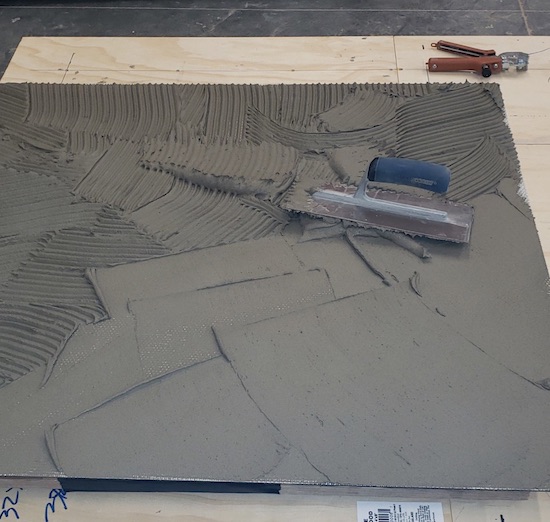
Definitions: old to new
Taking a step back for a moment, the old definitions as stated in the NTCA Reference Manual for back butter and buttering are:
“Back-butter: The spreading of a bond coat to the backs of ceramic tile just before the tile is placed.”
“Buttering: The spreading of a bond coat (followed by a mortar coat, a thinsetting bed mortar, or an organic adhesive) to the backs of ceramic tile just before the tile is placed.”
These old definitions were not as accurate as they could have been to describe the action that was to take place by the installer. Questions would come up like: How thick of a bond coat could be allowed for back-buttering? A buttering question might be: After spreading a bond coat of unknown thickness, how thick of a mortar coat would be needed? Regional differences took these old definitions to mean different techniques. Because of the confusion, new terms were chosen and then defined.
The new term “flat back-troweling” replaces back-buttering and “notched back-troweling” replaces buttering.
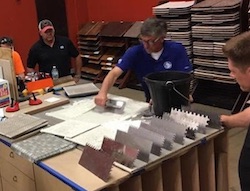

• Flat back-troweling, the term that replaces back-buttering, is defined as: The application using the flat side of the trowel (keying in or burning in of a thin layer of modified/non-modified dry-set (thin-set mortar) to the backside of ceramic, porcelain, glass and stone tile before the tile is placed. (Note: When done correctly, the flat side of the trowel will make a scraping sound on the tile back as pressure is applied to the surface.)
• Notched back-troweling, the term that replaces buttering, is defined as: After flat back-troweling has been completed, additional modified/non-modified dry-set mortar (thin-set mortar) is applied to the backside of ceramic, porcelain, glass and stone tile and uniformly combed in one direction with an appropriate notched trowel just before the tile is placed. (Caution: When notched back-troweling is used, the embed thickness of the dry-set mortar bed cannot exceed ANSI or manufacturer
requirements.)
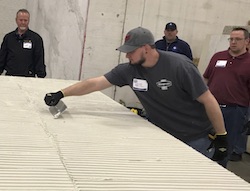

Understanding the new terms and definitions will help an installer know when to use flat back-troweling or when to use notched back-troweling. Substituting flat back-troweling (for back-buttering) tiles as stated in the ANSI standard (A108.5.2.3.5) is listed as an option to achieve coverage. Flat back-troweling may help with coverage, but by itself will not provide the necessary coverage for an installation. The other option to achieve the needed coverage is to “select a notched trowel sized to facilitate the proper coverage.” Selecting the properly-sized notch trowel to achieve the needed coverage for an installation is a key requirement for any properly-installed installation.
Flat back-troweling
Flat back-troweling (formerly back-buttering) can promote increased bonding strength of the bond coat material. By spreading the thin layer of bonding material to the back of the tile, the bonding material is now forced into any surface voids. The tile should be installed and embedded in a properly-prepared notched surface while the mortar is wet, ensuring the wet transfer of the mortar. This increases the bond strength, since the flat back-troweling has increased the bonding coat material contact to the back of the tile, versus a tile that was not flat back-troweled.
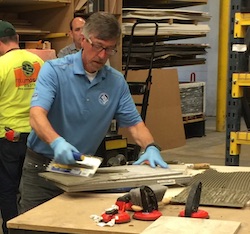

Flat back-troweling tiles can fill in the inherent warpage of a tile; however, one must pay attention to the dry-set mortar/thin-set mortar manufacturer’s maximum thickness allowed for the bonding material used. By filling the inherent warpage of a tile, the back plane of the tile is flatter and can be compressed uniformly into the properly-prepared notched mortar bed of the installation surface. This allows the notched mortar bed to fully collapse without voids and air pockets, thus providing the mortar coverage and support required per ANSI A108.5.2.3.4. Flat back-troweling is also recommended when installing stone or large-format tiles.
Notched back-troweling
Notched back-troweling (formerly buttering) has more limitations to its use; however, it is a technique required in the installation of Gauged Porcelain Tile Panels/Slabs (ANSI A108.19.13.6).
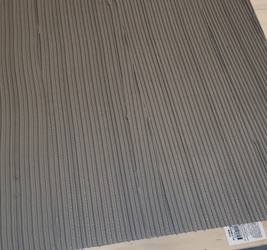

Notched back-troweling can also be used when tiling a ceiling, installing irregular or cleft stone, or installing handmade tiles that are naturally warped. As always, the notches must be in one direction, aligned (parallel) with the substrate notches, creating a zipper effect and fully collapsed to achieve the necessary mortar coverage and support.
In the future, when speaking of back-buttering and buttering, churn up the butter and make the shift to back-troweling whether it be flat back-troweling or notched back-troweling.


Jan Hohn
Simply put, Jan Hohn is passionate about tile. With 23 years of experience in the industry, she has a thorough understanding of what a quality installation requires above and below the tiled surface. This knowledge is derived not only from hands-on work in the field, but also from decades of attending and hosting industry-driven seminars and training workshops. Her technical expertise, honed skills and artisan eye for detail have helped Jan become a leader in her field, and she loves to share this passion with her clients.
Jan is perpetually active within the tile industry on a national level. She is currently a state director for the National Tile Contractors Association (NTCA), and sits on the NTCA’s Technical Committee as well as its Methods and Standards Committee. In addition, she is also on the Handmade Tile Association’s Board of Directors and attends the American National Standard Institute meetings when possible.
As one of only a few women tile contractors in the male-dominated world of construction trades, Jan has broken ground in the industry as the first woman to serve on NTCA’s board of directors. In addition, she is the first woman to serve on NTCA’s Technical Committee, first woman NTCA member to be a Certified Tile Installer, first woman to win the Tileletter Grand Prize Residential Award and the first woman to be awarded the NTCA’s Five Star Contractor accreditation.
Prior to starting Hohn & Hohn, Inc., Jan taught music, health and physical education, and was a production manager at Acadian Candles. In her free time, she is an avid gardener, maintaining 60 tropical plants throughout the year, and is an accomplished sailor – she raced Hobie-Cats for more than 30 years and is currently crewing on E-Scow boats. She also enjoys spending time with her family, entertaining and supporting the local music community.







